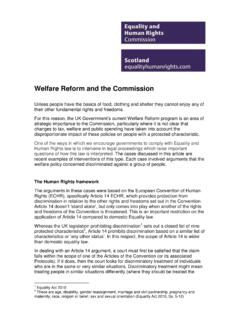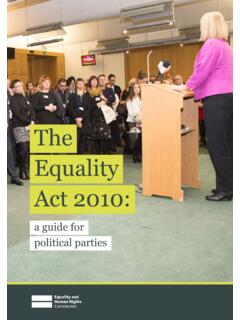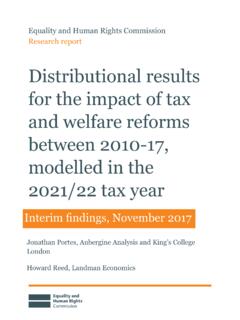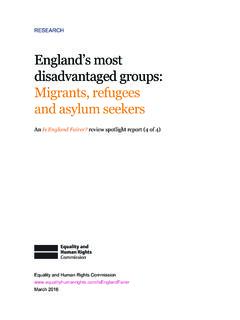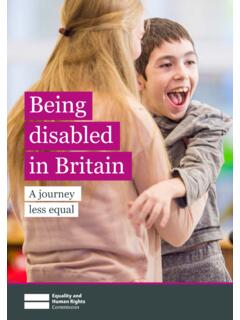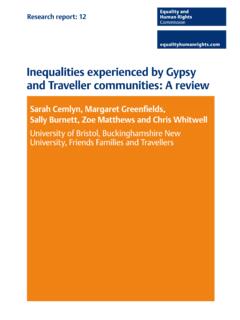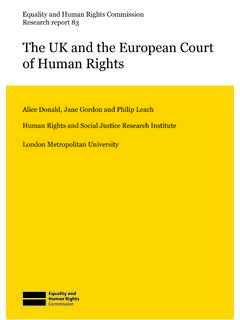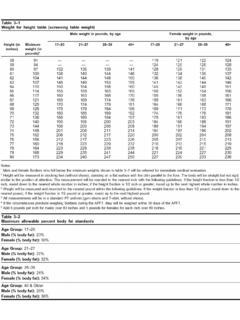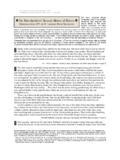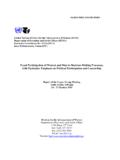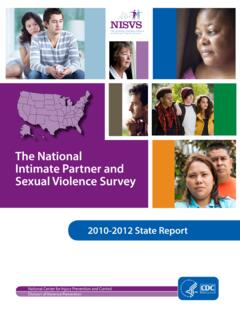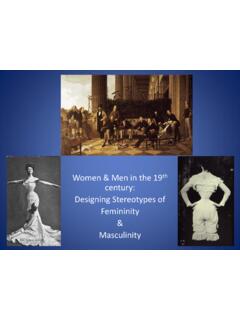Transcription of The disability pay gap - Equality and Human Rights Commission
1 The disability pay gap Equality and Human Rights Commission Research report 107 | Pay gaps researchSimonetta Longhi Institute for Social and Economic Research, University of Essex Equality and Human Rights Commission August 2017 i 2017 Equality and Human Rights Commission Published August 2017 ISBN 978-1-84206-688-1 Equality and Human Rights Commission Research Report Series The Equality and Human Rights Commission Research Report Series publishes research carried out for the Commission by commissioned researchers. The views expressed in this report are those of the authors and do not necessarily represent the views of the Commission . The Commission is publishing the report as a contribution to discussion and debate. Please contact the Research Team for further information about other Commission research reports, or visit our website.
2 Post: Research Team Equality and Human Rights Commission Arndale House The Arndale Centre Manchester M4 3AQ Email: Telephone: 0161 829 8100 Website: You can download a copy of this report in Microsoft Word and PDF formats from If you require this publication in an alternative format, please contact the Communications Team to discuss your needs at: Equality and Human Rights Commission August 2017 ii Contents Contents ii List of figures and tables iv List of abbreviations and acronyms vi Acknowledgements vii Executive summary viii Introduction viii Key findings viii Background x Methodology and definitions x 1 |Introduction 1 2 |Methodology 3 Data 3 Definitions 4 Analysis 6 3 |The disability pay gap: what we already know 8 Discrimination 8 Worker and job characteristics 9 The onset of disability 11 4 |Research findings: trends in employees and pay 13 Trends in employees 13 Trends in median pay 18 The Living Wage 20 Summary 22 5 |Research findings: drivers of the disability pay gap 25 Differences in characteristics 25 The role of characteristics on pay gaps for disabled men 26 Equality and Human Rights Commission August 2017 iii The role of characteristics on pay gaps for disabled women 33 Summary 37 6 |Research findings: further analysis 38 Types of disability 38 disability and ethnicity 40 7 |Conclusions 44 Introduction 44 Key findings 44 Implications 45 Bibliography 47 Datasets 49 Appendix A: Definition of disability 53 Appendix B.
3 Tables of descriptive statistics and regression results 56 Contacts 95 Equality and Human Rights Commission August 2017 iv List of figures and tables Figures Figure Percentage of men and women aged 16-64 who are employees by disability status over time Figure Percentage of men aged 16-64 who are employees by disability status over time Figure Percentage of women aged 16-64 who are employees by disability status over time Figure Median pay for men by disability status over time Figure Median pay for women by disability status over time Figure Percentage of men paid below the Living Wage by disability status Figure Percentage of women paid below the Living Wage by disability status Figure Pay gaps of disabled men Figure Impact of characteristics on pay gaps of men with a work-limiting only physical impairment Figure Impact of characteristics on pay gaps of men with an activity and work-limiting physical impairment Figure Impact of characteristics on pay gaps of men with a work-limiting only mental impairment Figure Impact of characteristics on pay gaps of men with an activity and work-limiting mental impairment Figure Impact of characteristics on pay gaps of men with activity and work-limiting other impairments Figure Pay gaps of disabled women Figure Impact of characteristics on pay gaps of women with a work-limiting only physical impairment Equality and Human Rights Commission August 2017 v Figure Impact of characteristics on pay gaps of women with an activity-limiting only physical impairment Figure Impact of characteristics on
4 Pay gaps of women with an activity and work-limiting physical impairment Figure Impact of characteristics on pay gaps for women with work-limiting only mental impairment Figure Pay gaps among men by type of impairment Figure Pay gaps among women by type of impairment Figure disability and ethnicity pay gaps among men Figure disability and ethnicity pay gaps among women Tables Table B1 Differences in characteristics of men by disability status (unweighted averages) Table B2 Differences in characteristics of women by disability status (unweighted averages) Table B3 Impact of characteristics on pay gaps of disabled men and women Table B4 Contribution of characteristics to pay gaps of disabled men Table B5 Contribution of characteristics to pay gaps of disabled women Table B Impact of characteristics on pay gaps of disabled people by type of impairment Table B7 Impact of characteristics on pay gaps of disabled men and women by ethnicity Equality and Human Rights Commission August 2017 vi List of abbreviations and acronyms LFS Labour Force Survey NVQ National Vocational Qualification ONS Office for National Statistics Equality and Human Rights Commission August 2017 vii Acknowledgements We are grateful to David Coulter, Anne Madden, Gregory Crouch, Karen Hurrell and Richard Keyte for their helpful suggestions.
5 We would also like to thank Maria Komodromou for her help with the literature search. We are also grateful to the Office for National Statistics for providing access to the Labour Force Survey via the UK Data Service. However, none of the original data creators, depositors or copyright holders, the funders of the data collections, nor the UK Data Service bear any responsibility for the analysis or the interpretation of the results. Crown copyright material is reproduced with the permission of the Controller of HMSO and the Queen's Printer for Scotland. disability pay gap Executive summary Equality and Human Rights Commission August 2017 viii Executive summary Introduction This research report explores the disability pay gap, which is defined as the difference between the average hourly pay of disabled and non-disabled people, through a brief literature review followed by a statistical analysis.
6 As well as looking at basic differences in pay, the research identifies the characteristics associated with those differences such as age, occupation and level of education. This analysis is intended to further debate and highlight areas where intervention may be needed. Key findings Research consistently finds that disabled people are less likely to be in employment than non-disabled people and when employed they receive, on average, lower pay. The causes of the disability pay gap are complex. However, there is evidence that disabled people face barriers and discrimination in employment. There are also differences in the personal characteristics of disabled people and non-disabled people that have an impact on the pay gap. For example, lower levels of education or reduced ability to work continuously on a full-time basis can have a negative impact on pay.
7 The overall employee rate1 of disabled people was about 35% in 2014 for both disabled men and women . Among non-disabled people it was around 63% for men and 57% for women . Only around a quarter of men and women aged 16-64 with a disability that was both activity-limiting and work-limiting had a paid job. Those people whose disability was activity-limiting but not work-limiting had higher employee rates than other disabled people. 1 Percentage of the population aged 16-64 in paid jobs, that is, as employees. disability pay gap Executive summary Equality and Human Rights Commission August 2017 ix The disability pay gap in the period 1997-2014 was 13% for men and 7% for women . Pay gaps among men are often larger than those among women . The size of the pay gap varies depending on the exact nature of the disability .
8 The pay gaps for those with neurological disorders, mental illness, learning difficulties or disabilities2 tend to be large:3 - Men with epilepsy experience a pay gap close to 40% (it is around 20% for women ). - Men with depression or anxiety have a pay gap of around 30% and women have a pay gap of 10%. Men with mental illness, or suffering from phobia, panics or other nervous disorders, experience a pay gap of around 40% (the pay gap for women was not statistically significant). - Men with learning difficulties or disabilities have a pay gap of around 60% (the pay gap for women was not statistically significant). The pay gaps for those with physical impairments are also substantial. Men with physical impairments generally experience pay gaps in the range of 15% to 28%, depending on the nature of the disability .
9 The difference between non-disabled women 's pay and that of women with physical impairments ranges from 8% to 18%. The extent to which a disability affects daily activities and work also has a bearing on the size of pay gaps. Those with an activity and work-limiting disability tend to experience large pay gaps. Among men, the pay gap for this group is about a quarter for those with a physical (24%) or other type of impairment (23%) and 40% for those with a mental impairment. Among women it is 14% for those with a physical impairment and 19% for those with a mental impairment. The analysis looks at the intersectionality of disability and ethnicity. It finds that where ethnic pay gaps exist, they tend to become larger when disability is factored in, but the disability pay gap does not seem to vary by ethnicity.
10 Disabled Bangladeshi and Pakistani men experience particularly large pay gaps of 56% and 36% respectively, and disabled Black African men a gap of 34% compared with White British non-disabled men. The pay gaps for disabled women from ethnic minorities were not generally found to be statistically significant. Certain characteristics tend to be associated with pay gaps across all disability groups and both genders, although their relative importance varies depending on 2 This includes people with a wide range of disabilities, from dyslexia to severe intellectual impairments. 3 Note however that these estimates have lower precision than others in this report, so the actual pay gaps may be substantially higher or lower than these estimates. See Chapter 6 for details.
